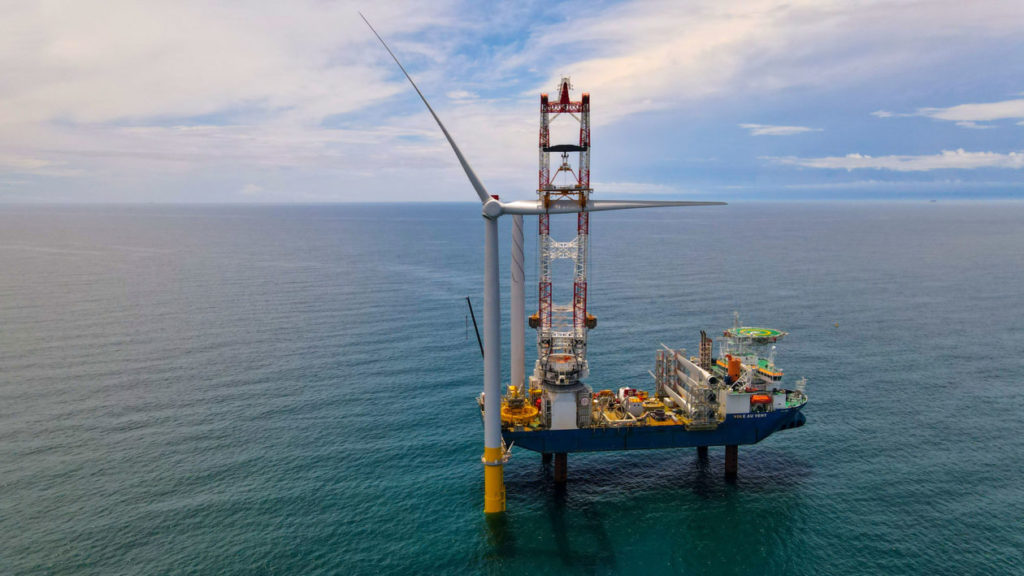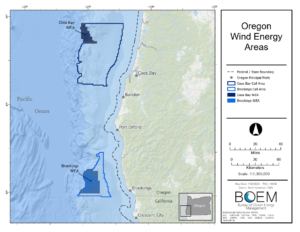
By ALEX BAUMHARDT/Oregon Capital Chronicle
The Biden administration will seek bids on developing two wind energy sites off Oregon’s southern coast in October.
The announcement Thursday followed an environmental assessment of the sites off Coos Bay and Brookings by the Bureau of Ocean Energy Management. The analysis found the sites would pose “no significant” impact on people or the environment.
“The advancement of the first offshore wind sale in Oregon marks years of engagement with state partners, tribes, ocean users and industry, and the administration’s commitment to building a thriving and sustainable clean energy industry,” Interior Secretary Deb Haaland said in a release.
The release said the sites could generate more than 3.1 gigawatts of renewable energy if fully developed, enough to power 1 million homes.

The sites would cover 61,200 acres off the coast of Coos Bay and 133,808 acres off the coast of Brookings. The Coos Bay site is 30 miles from the coast and the Brookings area is 20 miles away. The Department of the Interior said the granting of any leases would not constitute approval of development plans. To move forward, they would need to pass an environmental, technical and public reviews, including input from tribes, state and federal agencies and the public.
Five Oregon and California tribes, members of the seafood industry and some locals oppose the developments. Critics said federal officials have failed to be forthright about their plans, and last November, the tribal council of the Confederated Tribes of the Coos, Lower Umpqua and Siuslaw Indians passed a resolution against the sites. It said the bureau had failed to show that the development would not harm the tribes.
In November, Coos County residents will vote on a ballot initiative on the development. A coalition of independent fishing boat operators, seafood companies and industry groups also have asked Oregon Gov. Tina Kotek to intervene to stop the development.
Oregon needs to switch from fossil fuels to clean, renewable energy to meet its emission-reduction goals. The current Climate Protection Program by the Department of Environmental Quality – which needs final approval – set a target of reducing emissions from fossil fuels by 50% by 2035 and by 90% by 2050.
Wind energy could inch Oregon towards that goal but it only accounts for a fraction of the state’s energy use. The Oregon Department of Energy’s latest energy report said wind power accounted for 7% of energy consumption in 2000.
The Bureau of Ocean Energy Management has auctioned five areas off the California coast to develop floating wind energy projects, and it has approved six projects on the East Coast. They’re part of the Biden administration’s plan for up to a dozen offshore wind energy auctions through 2028. The administration is targeting a total of 30 gigawatts of wind energy to be deployed by 2030 – enough to power more than 10 million homes for a year.
Four companies have qualified to bid on Oregon leases: Portland-based Avangrid Renewables, the Spanish companies BlueFloat Energy and Ocean Winds, and the Irish company Mainstream Renewable Power, according to the ocean energy bureau.
Leases are likely to be awarded before Oregon releases its plan for offshore wind development in 2025, and construction would likely take place over the next five years. The projects would need electric transmission systems along the coast to undergo major upgrades.
The state’s planned Offshore Wind Roadmap is part of House Bill 4080 passed this year to lay the foundation for offshore wind energy that complies with labor standards and with community input.
Assessment says minor impacts
In its environmental assessment, officials determined that building wind projects in the two areas off Oregon’s Coast would have negligible to moderate impacts on marine mammals and sea turtles due to noise from underwater surveying and potential entanglement in mooring systems and buoys. The most important factors that could affect marine animals and sea turtles, officials said, are vessels striking wind turbine infrastructure. For marine and coastal birds, the potential harm from underwater noise, boat and air traffic, trash and debris and accidental fuel spills were deemed negligible.
Commercial fisheries are likely to experience minor issues related mainly to increased marine traffic while the projects are being built, officials wrote. The companies developing projects would be required to work with local fisheries to coordinate traffic while installation and surveying is underway. Recreational fishing, specifically albacore and tuna fisheries in Coos County or near Coos Bay, could be adversely affected intermittently over a five year term, but the report said officials said they expect a full recovery to recreational fishing once construction is done.
The projects would bring an economic boost to coastal ports and counties by creating jobs and bringing people to the area during construction. But the report said the economic impact would be short term and difficult to measure.
The report identified few economic bonuses for nearby tribes, including the Confederated Tribes of the Coos, Lower Umpqua and Siuslaw Indians, and the agency said it would consult with tribes on any project proposals and would include tribes in the environmental reviews.
- Oregon Capital Chronicle is a nonprofit Salem-based news service that focuses its reporting on Oregon state government, politics and policy.




While I strongly support alternative energy sources, I believe in cases of potentially strong conflicts with other resource uses such as fishing, marine protection and subsistence uses, the DOE and BOEM should ensure successful coordination and engagement throughout the review process. Also, I’m not impressed with the agency’s ability to break a project into smaller pieces for environmental analysis under NEPA because the impacts can appear smaller and it’s difficult to look at cumulative effects. In fact, NEPA clearly does not allow doing that but TFG allowed DOE to use a modified EA and I don’t think that has changed.
Having worked in long-term power planning at the Bonneville Power Administration I have an appreciation of how complicated the power business can be. There are non-profit and for-profit electric utilities. There are regulated markets and unregulated markets. And there are different metrics like power, energy, demand, and capacity. There are control areas and control area operators who must ensure, in real time, that generation follows load.
For a generating resource to have “capacity”, it must be able to ramp up and down and follow a load. Coal, combustion turbines, large hydro, and nuclear power plants can ramp up and down and follow a load. Wind generation can’t.
Wind only generates when the wind blows and the wind isn’t correlated to human activity and it can’t be ramped up and down, so, from a power planning perspective, wind generation has no capacity. If it’s 105 degrees outside and you want to turn on your air conditioning, but the wind isn’t blowing, then some other load following generating resource is needed to provide for that demand.
Years ago, after California deregulated the bulk power market, they suffered through a summer of rolling brown-outs. The public power companies, were forced to purchase needed capacity from a newly deregulated bulk power market. The bulk power marketers took advantage by taking generating resources off-line during extreme weather events, causing the price of capacity to spike. It was pure greed, but greed lives on.
Sure, 3.1 gigawatts of energy is enough to service 1 million homes, but It will provide zero capacity to those homes. In an extreme weather event, if the wind isn’t blowing, capacity to power those million homes will have to be purchased on the bulk market, and that is exactly what happened in California.
I’m all for clean renewable power but we need to be clear-eyed about capacity because the bulk power market – where utilities and control area operators go to buy capacity during extreme weather events – is unregulated.
So I offer this simple question: Where do we get 3.1 megawatts of capacity, and how much will it cost.
I agree with the previous comment that the BOEM and DOE are charged with making technical progress on new energy generation without the responsibility to uphold ocean environment, fisheries, or tribal concerns. This reflects the Tennessee Valley Authority work of the past. I’m all for wind energy but we need to step more carefully in new mega projects than we have in the past. Where is a link to “the report” that the BOEM created?